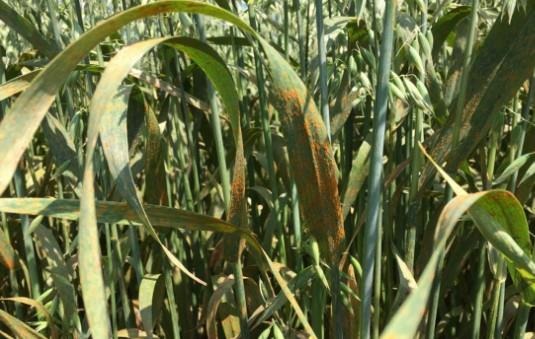Development
Crown rust can develop on oats at any growth stage, provided there is inoculum and the weather is favorable for infection. Spores are airborne and may blow up from southern states (sometimes viable spores can travel for hundreds of miles) or overwinter on alternate plant hosts, such as buckthorn (Figure 1).
Unlike other cereal rusts, the crown rust pathogen overwinters in South Dakota on buckthorns. The presence of crown rust inoculum on buckthorns can be an indication of the likely risk for crown rust to develop during the oat growing season.
Symptoms
When spores infect a leaf, they develop oval, orange-colored pustules on the leaf within 7 to 10 days. These pustules can effectively coat the leaves of an oat plant, reducing photosynthesis (Figure 2).

Figure 2. Oats infected with crown rust.
Environmental Conditions
Crown rust is favored by mild to warm temperatures between 68°to 77° F and wet conditions. Wind facilitates movement of spores from oat stubble to buckthorns and back to oats during the growing season. Wind and rain splash also spread the spores within the oat field. Dry and hot weather (>86° F) prevents infection from taking place. Infections that take place before flag leaf emergence cause the greatest yield loss.
Management
The best management practice for crown rust is planting resistant cultivars. In-season crown rust management can be achieved by a well-timed fungicide application at the flag leaf growth stage. Fungicide applications timed before flag leaf emergence will leave the flag leaf unprotected and susceptible to infection. A few fungicides registered for oats in South Dakota include Stratego YLD, Quilt Xcel, Priaxor and Trivapro. These have good efficacy against crown rust.
Fungicide Effects on Yield
The South Dakota State University Crop Performance Testing program tests oat varieties with and without a fungicide treatment at the Volga Research Farm on an annual basis. In 2021, there was no response to fungicide, as dry and hot conditions did not favor the development of crown rust. In 2020, a set of varieties treated with a fungicide at flag leaf emergence (Feekes 8.0) averaged 21 bu/acre and 3.2 lbs./bu better test weight than non-treated varieties (Table 1).
TABLE 1. THE EFFECT OF FUNGICIDE APPLICATION ON YIELD AND TEST WEIGHT
FOR SIX OAT VARIETIES ADAPTED TO SOUTH DAKOTA.
| Variety | Crown rust scorea | Untreated | Fungicideb |
|---|
| - | - | Yield (bu/a) | Test Wt (lb/bu) | Yield (bu/a) | Test Wt (lb/bu) |
| Warrior | 4 | 109 | 31.6 | 117 | 31.7 |
| Deon | 6 | 94 | 30.9 | 126 | 32.9 |
| MN Pearl | 6 | 99 | 30.2 | 126 | 32.9 |
| Goliath | 9 | 71 | 29.5 | 122 | 34.4 |
| Hayden | 9 | 67 | 26.5 | 118 | 33.4 |
| Shelby427 | 9 | 61 | 30.7 | 110 | 33.4 |
| Trial Average | - | 83 | 29.9 | 120 | 33.1 |
a Crown rust scores: 1 (very tolerant) - 9 (very severe symptoms)
b 7 oz/acre Stratego applied at Feekes 8.0 (flag leaf emerged)
Source : sdstate.edu